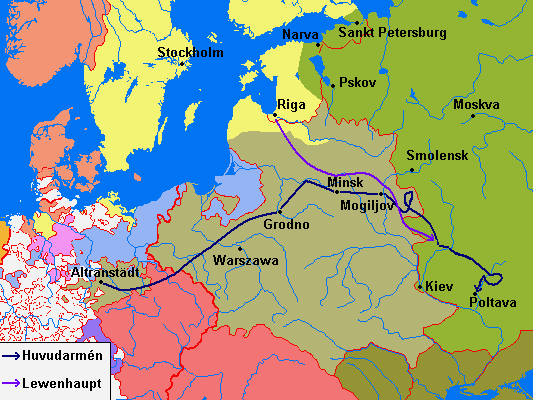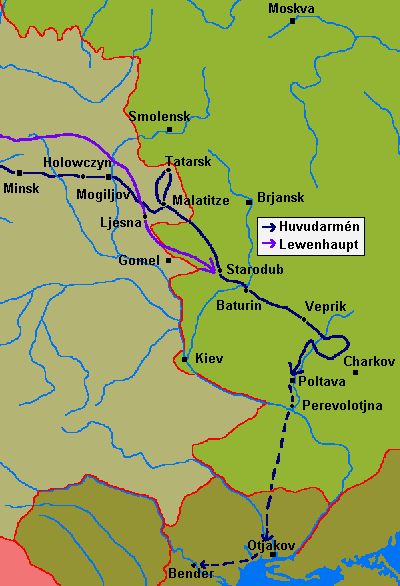|
Road to Poltava

Of the three
countries that attacked Sweden in 1700 all but Russia had been forced to sue
for peace after the Swedish king Charles XII invaded Saxony in 1706.
Charles XII spent a year in Saxony preparing for the final confrontation
with the Russian tsar Peter I while building up his army. The Russian
campaign began in August 1707 when the Swedish main army ("Huvudarmén" in
the maps) with a strength of up to 44 000 men left their quarters in Saxony
to march through Poland. Because of Russian support to the Polish opposition
was Charles XII forced to detach 8 000 men commanded by Krassow to
bolster the pro-Swedish king Stanisław Leszczyński. The rest of
the army continued its march in December through Masuria where Polish
peasants waged a guerrilla war against the Swedes. But this did not prevent
them from seizing Grodno from the Russians at the end of January.
 During
the whole spring of 1708 the Swedish army lay still in Belarus preparing for
this year's campaign. Lewenhaupt who was in charge of Swedish forces in the
Baltics provinces was ordered to join his army (13 000 men) with the main
army during the summer together with supplies. Lewenhaupt was however
unwilling to carry out his order and deliberately delayed the execution of
it. It was not until the Russian army in the Baltics was pulled back in
August that Lewenhaupt began to put some effort to his mission. In the
meantime Charles XII had been active since early June and defeated a large
Russian force in the battle of Holowczyn 4 July.
After this the main army waited for a month in Mogiljov until it made an
advance to Smolensk. But a shortage of supplies forced the army to turn
south to Severia in the middle of September. Charles XII who believed that
Lewenhaupt was much closer to the main army then he actually was put
Lewenhaupt's army in great danger with this change of direction. A large
Russian force was detached to attack Lewenhaupt's numerically inferior army.
The two armies met at Lesnaya 29 September and fought a tactically
indecisive battle.
Lewenhaupt had however no other choice than to retreat in the middle of the
night which led to large part of his army being scattered. Furthermore the
large baggage train had to be abandoned and with the infantry mounted on
horses a quick march south was carried out to join the main army. When
Lewenhaupt arrived to his destination 9 October only 6 000 men remained
of his army. During
the whole spring of 1708 the Swedish army lay still in Belarus preparing for
this year's campaign. Lewenhaupt who was in charge of Swedish forces in the
Baltics provinces was ordered to join his army (13 000 men) with the main
army during the summer together with supplies. Lewenhaupt was however
unwilling to carry out his order and deliberately delayed the execution of
it. It was not until the Russian army in the Baltics was pulled back in
August that Lewenhaupt began to put some effort to his mission. In the
meantime Charles XII had been active since early June and defeated a large
Russian force in the battle of Holowczyn 4 July.
After this the main army waited for a month in Mogiljov until it made an
advance to Smolensk. But a shortage of supplies forced the army to turn
south to Severia in the middle of September. Charles XII who believed that
Lewenhaupt was much closer to the main army then he actually was put
Lewenhaupt's army in great danger with this change of direction. A large
Russian force was detached to attack Lewenhaupt's numerically inferior army.
The two armies met at Lesnaya 29 September and fought a tactically
indecisive battle.
Lewenhaupt had however no other choice than to retreat in the middle of the
night which led to large part of his army being scattered. Furthermore the
large baggage train had to be abandoned and with the infantry mounted on
horses a quick march south was carried out to join the main army. When
Lewenhaupt arrived to his destination 9 October only 6 000 men remained
of his army.
Charles XII's
advance guard had during the march through Severia failed to take
strategically important strongholds and encouraged by the Cossack leader Mazepa's
rebellion the Swedish army decided to continue marching further south to the
Ukraine. The Russians however responded quickly and seized Mazepa's fortress
Baturin 2 November, in which important supplies had been waiting for the
Swedes. A new Cossack leader was appointed by the Russians and the campaign
developed into a Ukrainian civil war in which the Russians mercilessly
stamped down all tendencies to rebellion. The Swedes on the other hand tried
to force the Russians out of the region to encourage the Cossacks to rebel
as well as securing supplies for the army. The fighting was limited only by
an exceptionally cold winter which caused thousands to suffer from
frostbites on both sides. Another setback for the Swedes was the storming of
the fortress Veprik, which was seized 7 January but to a cost of over 1 000
killed. During the month of February a new Swedish offensive was carried out
but it had to be aborted when mild weather made movements difficult.
In the
following months the Zaporozhnian Cossacks joined the Swedish side and
Charles XII changed strategy when he in the beginning of April began to
blockade the Russian fortress at Poltava. A formal siege began later in May.
In the months leading to the battle on 28 June the Russians made several
attempts to relieve Poltava and the opposing armies came ever closer to each
other. This also meant that the armies pulled back forces from other areas
and concentrated their strength in a very limited space, thus causing supply
difficulties for the Swedes. The entire Russian army crossed the river
Vorskla on 21 June and set up a fortified camp north of Poltava. Five days
later the camp was moved further south so that it stood only about five
kilometres north of Poltava. The proximity between the two armies made a
battle within the coming days unavoidable. The Russians had however hopes
that the hard pressed Swedes would be forced out without a fight. But the
Swedish response to these movements was delayed because the Charles XII had
been shot in his foot 17 June during a diversionary attack by the Russians
south of Poltava. The injury became infected and the king's life was for a
while in danger. The Russians used this extra time to fortify their position
by building redoubts and for each passing day it would become harder for the
Swedes to defeat them. The Swedish army could not wait for Charles XII's
recovery so the task fell to field marshal Rehnsköld to lead the army on the
fateful day 28 June 1709. Read
about the
Battle of Poltava. |

